Question
See the multiple-choice question below, which deals with how to treat a grant from an employer that pays for tuition. I do not ask you
See the multiple-choice question below, which deals with how to treat a grant from an employer that pays for tuition. I do not ask you to answer the multiple-choice question. The correct answer is C.
Required: Rank the four answers from most attractive to the taxpayer to least attractive to the taxpayer, ignoring the fact that the correct answer is C. No partial credit. Half credit for no explanation or inadequate explanation.
|
| Copy and paste entire letter answer from multiple-choice question below | Explanation why this answer is most/least attractive or somewhere in between |
| Most attractive |
|
|
| 2nd most |
|
|
| 2nd least |
|
|
| Least attractive |
|
|
Additional comments (you can earn maximum points if comment is insightful above and beyond the requirements):
|
|
| [3] Bill Walden received a $2,100 grant from his employer and, as required by his employer, used all of the money for tuition and fees to take three graduate-school courses during the period September 1 to December 31 of the current year. Walden is not a candidate for a degree and has never received a scholarship or fellowship grant before. He had previously met the minimum educational requirements for his employment position; however, due to new requirements established by his employer, these courses were necessary for him to retain his job. In computing his current-year taxable income, Walden should include
A. Gross income of $2,100 and an education expense deduction of $2,100. B. Gross income of $2,100 and no education expense deduction. C. No gross income and no education expense deduction. D. Gross income of $0 and an education expense of $2,100.
The correct answer is C.
A. The grant is excludable and nondeductible. B. The education grant is excludable. C. The grant is excludable from income under the employer educational assistance program. The educational assistance plan must be nondiscriminatory, and the benefits cannot exceed $5,250 for the tax year. Graduate-level courses are eligible for the exclusion. D. The $2,100 payment is nondeductible. |
Step by Step Solution
There are 3 Steps involved in it
Step: 1

Get Instant Access to Expert-Tailored Solutions
See step-by-step solutions with expert insights and AI powered tools for academic success
Step: 2

Step: 3

Ace Your Homework with AI
Get the answers you need in no time with our AI-driven, step-by-step assistance
Get Started


